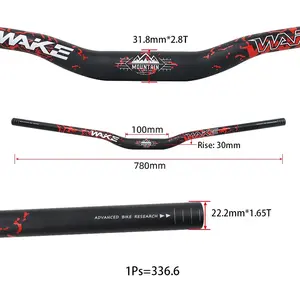
WAKE Ultralight Swallow-Shaped 31.8mm*720mm/780mm Bicycle Handlebar MTB Handlebar Bicycle Riser Handle Bar Cycling Handlebar


Carbon fiber bicycle handlebar Reduce resistance bent bar strengthen bike parts 400/420/440mm inner routing ud matte





















Bike bars, the central point of control on bicycles, come in various forms to cater to different riding styles and preferences. From the urban commuter's flat bar road bike to the rugged mountain bike handlebars, the diversity in design is essential for both comfort and control. This introduction delves into the types, applications, and features of bike bars, providing a comprehensive guide for buyers seeking the ideal fit for their cycling needs.
The type of bike bar selected can dramatically affect the bike's handling and rider's ergonomics. Flat bar gravel bikes offer a comfortable upright position, ideal for off-road adventures and long-distance tours. In contrast, bullhorn handlebars, often seen on urban bikes, provide an aerodynamic stance suitable for speed and agility in cityscapes. Bullhorn bike handlebars are particularly popular among fixed-gear enthusiasts for their minimalist aesthetic and performance.
When considering bike bars, the material is a significant factor. Lightweight options like those used in aero road bikes enhance speed and reduce overall bike weight. Durability is also paramount, especially for BMX handlebars, which must withstand the rigors of stunt riding and frequent impacts. Ergonomics play a crucial role as well, with designs like the ergon gp5 offering integrated grips for additional hand positions and comfort during long rides.
Choosing the appropriate bike bar can lead to a more enjoyable and efficient riding experience. For instance, the surly corner bar is designed to transform drop bar road bikes into flat bar setups without altering the geometry, offering a new riding dynamic. Similarly, the surly preamble and surly ghost grappler handlebars are engineered to provide riders with multiple hand positions, reducing fatigue and increasing control on varied terrains.
In summary, the bike bar is a pivotal component that influences a bicycle's handling, comfort, and overall performance. Whether seeking a cycle bar for urban commuting or specialized road bike handlebars for competitive racing, understanding the nuances of each type is crucial. By considering the specific applications and advantages of different bike bars, cyclists can make informed decisions to enhance their riding experience.